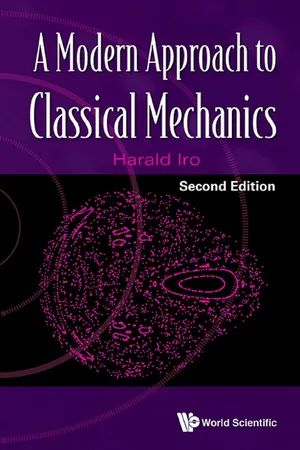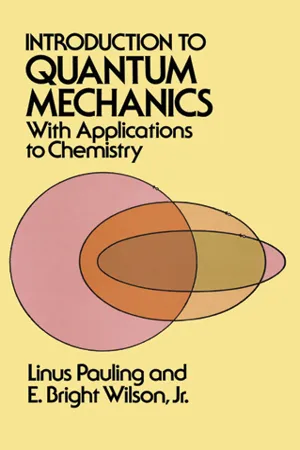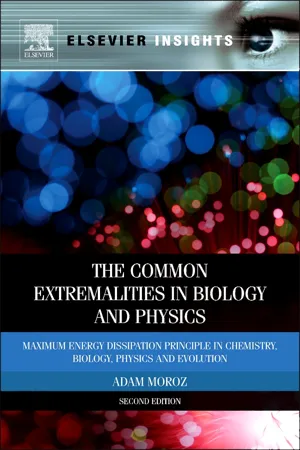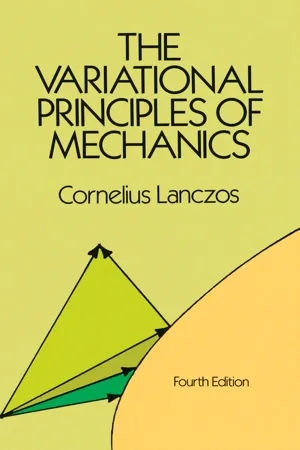Physics
Lagrangian
In physics, the Lagrangian is a function that summarizes the dynamics of a system. It is defined as the difference between the kinetic and potential energies of the system. The principle of least action, based on the Lagrangian, provides a powerful framework for describing the behavior of physical systems.
Written by Perlego with AI-assistance
Related key terms
Related key terms
1 of 4
Related key terms
1 of 3
5 Key excerpts on "Lagrangian"
- eBook - ePub
- Harald Iro(Author)
- 2015(Publication Date)
- WSPC(Publisher)
9Lagrangian mechanics
At the end of the 18th century, an important stage in the development of classical mechanics was achieved. In 1788 Lagrange presented mechanics in a uniform, clear and very elegant manner in his “Mécanique analytique”. Lagrange’s book is the first comprehensive representation of analytical mechanics. It is an edifice of ideas: the building blocks are logical related to each other. The representation of physical processes by mathematical theories and models is unified and elegant. This “Analytical Mechanics” is a ‘phenomenal achievement in the economy of thought1 ’ (E. Mach, “The Science of Mechanics”).The treatment in this chapter differs from the historical development: Lagrange’s work is based on D’Alembert’s principle2 and on the concept of virtual displacements; we consider neither in this book. Instead, after a brief account of the calculus of variations, Lagrangian mechanics is introduced by identifying Newton’s equation of motion with the Euler-Lagrange equations for the Lagrangian.9.1 Constrained motion
In many problems in classical mechanics, we are given not only the forces, but also certain constraints that the orbits must obey. For example, in the case of the pendulum, the mass must remain a constant distance away from the pivot point. One distinguishes various kinds of constraints. A constraint depending only on the position r(t) of the particle and on time t, i.e. of the formis called a holonomic constraint. (In the case of the pendulum, the holonomic constraint is r2 (t) − l2 = 0.) Constraints that cannot be written in this form, for example, those that- Contain velocities or differentials only of the radius vectors (e.g.: or,- Appear only as inequalities,are non-holonomic. Examples of systems with non-holonomic constraints include:- The motion of a particle restricted to the interior of a sphere, |r(t)| ≤ R;- A wheel (radius R) rolling on a surface. Here the constraint v = relates the angular velocity of the wheel to its linear velocity v - Linus Pauling, E. Bright Wilson, E. Bright Wilson(Authors)
- 2012(Publication Date)
- Dover Publications(Publisher)
quadrupole moment of the system, and higher powers form higher moments. The rate of emission of radiant energy as a result of the change of quadrupole and higher moments of an atom or molecule is usually negligibly small in comparison with the rate of dipole emission, and in consequence dipole radiation alone is ordinarily discussed. Under some circumstances, however, as when the intensity of dipole radiation is zero and the presence of very weak radiation can be detected, the process of quadrupole emission is important.4. SUMMARY OF CHAPTER IThe purpose of this survey of classical mechanics is twofold: first, to indicate the path whereby the more general formulations of classical dynamics, such as the equations of motion of Lagrange and of Hamilton, have been developed from the original equations of Newton; and second, to illustrate the application of these methods to problems which are later discussed by quantum-mechanical methods.In carrying out the first purpose, we have discussed Newton's equations in Cartesian coordinates and then altered their form by the introduction of the kinetic and potential energies. By defining the Lagrangian function for the special case of Newtonian systems and introducing it into the equations of motion, Newton's equations were then thrown into the Lagrangian form. Following an introductory discussion of generalized coordinates, the proof of the general validity of the equations of motion in the Lagrangian form for any system of coordinates has been given; and it has also been pointed out that the Lagrangian form of the equations of motion, although we have derived it from the equations of Newton, is really more widely applicable than Newton's postulates, because by making a suitable choice of the Lagrangian function a very wide range of problems can be treated in this way.In the second section there has been derived a third form for the equations of motion, the Hamiltonian form, following the introduction of the concept of generalized momenta, and the relation between the Hamiltonian function and the energy has been discussed.In Section 3- eBook - ePub
The Common Extremalities in Biology and Physics
Maximum Energy Dissipation Principle in Chemistry, Biology, Physics and Evolution
- Adam Moroz(Author)
- 2011(Publication Date)
- Elsevier(Publisher)
Similar to mechanics, the relationships between the degrees of freedom described by the functions of field (wave function) can be obtained by the variational method on the basis of the ideology of the least action principle. Therefore, it is reasonable to remember the main points of its formulation for the purpose of finding out the penalty forming the sense of the Lagrange approach for the most frequently considered physical fields. It would in turn allow the analysis of the energetical penalty formation to be carried out, having connected it eventually with penalty formulation (i.e., the MED principle) in biology.So in the case of mechanics, the Lagrange function depends directly on coordinates, their derivatives, and time:(5.65)As we know, in the field theory, the free fields are described on the basis of the least action principle [4] :Frequently, for a more expedient expression, the following designations can be used for the derivatives on space-time coordinates:(5.66)where S is the integral of action accepting the least possible value, L is the Lagrangian, i.e., the density of the Lagrange function for the fields, xiis independent space-time variables, uiis the set of functions of field (the components of wave functions), and ∂ui/ ∂xvis the derivatives on space-time coordinates.(5.67)and then the variation for the field may be written as:(5.68)and the Euler–Lagrange equations will be(5.69)By solving them relative to the functions of fields, one can obtain the expressions for the measured physical quantities. Let us consider some standard examples for the theory of field.5.3.1. Scalar Field
- eBook - ePub
- Robert Weinstock(Author)
- 2012(Publication Date)
- Dover Publications(Publisher)
Lagrangian —as6-2. Hamilton’s Principle. Lagrange Equations of Motion(a ) Although Newton’s laws of motion are the most fundamental mathematical description of mechanical phenomena in general, it best suits the purposes of our study to assume the validity of Hamilton’s principle as the physical law which describes the motion of any system of the type considered in 6-1 above. The principle of Hamilton reads:The actual motion of a system whose Lagrangian isis such as to render the (Hamilton’s) integralwhere t 1 and t 2 are two arbitrary instants of time , an extremum withrespect to continuously twice-differentiable functions q 1 (t ), q 2 (t ), …,qN(t )for which qi(t 1 )and qi(t 2 ) are prescribed for all i = 1, 2, …, N . We accept Hamilton’s principle as applicable to the motion of any conservative system.Although it is in some places stated that Hamilton’s principle may be used to replace Newton’s laws of motion as the fundamental starting point for mechanical systems possessing a Lagrangian, it should be realized that Newton’s laws are implicitly employed in the preceding paragraphs in at least two ways: (i) The definition of mass resides in Newton’s third law. (ii) In the tacit assumption that our system of coordinates is fixed relative to an inertial frame of reference, we make use of Newton’s first law, by means of which an inertial frame is defined.(b ) With the result (57 ) of 3-8(a ) we conclude from Hamilton’s principle that the generalized coordinates describing the motion of a system of particles must satisfy the set of Euler-Lagrange equationsThe equations (8 ), Lagrange’s equations of motion, constitute a set of N simultaneous second-order differential equations, whose solution yields the functions q 1 (t ), q 2 (t ), …,qN(t ). The 2N constants involved in the general solution of (8 ) are evaluated when the initial (t = 0, for example) values of all theqiand (i = 1, 2, …, N ) are given. Once the initial state of the system is thus prescribed, its future motion is described in detail by the functions obtained through the solution of (8 - eBook - ePub
- Cornelius Lanczos(Author)
- 2012(Publication Date)
- Dover Publications(Publisher)
Summary. The method of the Lagrangian multiplier remains valid even in the case of non-holonomic auxiliary conditions. The forces exerted on account of these conditions are once more furnished. These forces are of a polygenic nature. Non-holonomic auxiliary conditions and polygenic forces have the same effect in the Lagrangian equations of motion: they produce a “right-hand side” of these equations.10. Small vibrations about a state of equilibrium. One of the most beautiful examples of the power of the analytical method is the application of the Lagrangian equations to the theory of small vibrations about a state of stable equilibrium. This theory is of basic importance for the elastic behaviour of solids, for the vibrations of structures, for the theory of specific heat and other fundamental problems. The most impressive feature of this theory is its great generality. No matter how simple or how complicated a mechanical system is, its motion near a state of equilibrium is always describable in the same terms. The actual calculation gets complicated if the number of degrees of freedom is large* But the theoretical aspects of the problem remain unchanged.The simplifications which occur in this problem are due to the fact that the vibrations are small. We know that the geometry of the configuration space is not Euclidean but Riemannian. But we also know that the curved Riemannian space flattens out more and more if we restrict ourselves to smaller and smaller regions. This behaviour of the Riemannian space finds its analytical expression in the fact that the line elementwhere the aik are functions of the qi can be replaced by a separate line element with constant coefficients if we do not leave the immediate neighbourhood of the point P. The aik change so little in that neighbourhood that we can replace them by their values at the point P.Let the point P, which is the C-point representing the state of the mechanical system in the configuration space, be a point of equilibrium. For the sake of simplicity, let us agree that the point P shall be at the origin of our reference system, which means that its coordinates are qi = 0. We now consider the line element (510.1 ), with the aik constant, as applicable to the whole of space. The new space is Euclidean, but the error we thus commit tends towards zero as we approach the point P
Index pages curate the most relevant extracts from our library of academic textbooks. They’ve been created using an in-house natural language model (NLM), each adding context and meaning to key research topics.
Explore more topic indexes
Explore more topic indexes
1 of 6
Explore more topic indexes
1 of 4




